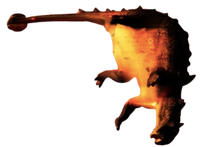
| Deinocheirus Temporal range: Late Cretaceous | |
|---|---|
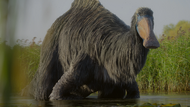
| |
| Image from the documentary Prehistoric Planet | |
| Scientific classification | |
| Kingdom: | Animalia |
| Phylum: | Chordata |
| clade: | †Ornithomimosauria |
| Order: | Saurischia |
| Suborder: | Theropoda |
| Family: | †Ornithomimidae |
| Subfamily: | †Ornithomiminae |
| Genus: | †Deinocheirus Osmólska & Roniewicz, 1970 |
| Type species | |
| †Deinocheirus mirificus Osmólska & Roniewicz, 1970 | |
Deinocheirus (pronounced: dy-no-ky-rəs, Greek word for: 'terrible hand') is a genus of large Deinocheirid ornithomimosaurian theropod dinosaur, which lived in what is now southern Mongolia, during the late Cretaceous Period (Nemegt Formation, dating to around 70 million years ago). It was previously thought that it was a huge representative of the family Dromaeosauridae. This was refuted by finding other parts of the body.
Discovery[]
The first known fossil remains of Deinocheirus were discovered by Polish paleontologist Zofia Kielan-Jaworowska on July 9, 1965, at the Altan Ula III site (coordinates: 43°33.987′N 100°28.959′E) in the Nemegt Basin of the Gobi Desert. She was part of a Polish group accompanied by Mongolian palaeontologist Rinchen Barsbold during the 1963–1965 Polish-Mongolian paleontological expeditions, which were organized by the Polish Academy of Sciences and the Mongolian Academy of Sciences. The crew spent July 9–11 excavating the specimen and loading it onto a vehicle. A 1968 report by Kielan-Jaworowska and Naydin Dovchin, which summarized the accomplishments of the expeditions, announced that the remains represented a new family of theropod dinosaur.
The specimen was discovered on a small hill in sandstone, and consists of a partial, disarticulated skeleton, most parts of which had probably eroded away at the time of discovery. The specimen consisted of both forelimbs, excluding the claws of the right hand, the complete shoulder girdle, centra of three dorsal vertebrae, five ribs, gastralia (belly ribs), and two ceratobranchialia.

The two forelimbs of the holotype specimen, MPC-D 100/18.
The specimen was made the holotype of Deinocheirus mirificus, named by Halszka Osmólska and Ewa Roniewicz in 1970. The generic name is derived from Greek deinos (δεινός), meaning "horrible", and cheir (χείρ), meaning "hand", due to the size and strong claws of the forelimbs. The specific name comes from Latin and means "unusual" or "peculiar", chosen for the unusual structure of the forelimbs. The Polish-Mongolian expeditions were notable for being led by women, among the first to name new dinosaurs. The original specimen number of the holotype was ZPal MgD-I/6, but it has since been re-catalogued as MPC-D 100/18. Forelimbs and shoulder girdles of holotype specimen MPC-D 100/18 on temporary exhibit in CosmoCaixa.
The paucity of known Deinocheirus remains inhibited a thorough understanding of the animal for almost half a century onwards, and the scientific literature often described it as among the most "enigmatic", "mysterious", and "bizarre" of dinosaurs. The holotype arms became part of a traveling exhibit of Mongolian dinosaur fossils, touring various countries. In 2012, Phil R. Bell, Philip J. Currie, and Yuong-Nam Lee announced the discovery of additional elements of the holotype specimen, including fragments of gastralia, found by a Korean-Mongolian team which re-located the original quarry in 2008. Bite marks on two gastralia were identified as belonging to Tarbosaurus, and it was proposed that this accounted for the scattered, disassociated state of the holotype specimen.
Additional specimens[]
In 2013, the discovery of two new Deinocheirus specimens was announced before the annual Society of Vertebrate Paleontology (SVP) conference by Lee, Barsbold, Currie, and colleagues. Housed at the Mongolian Academy of Sciences, these two headless individuals were given the specimen numbers MPC-D 100/127 and MPC-D 100/128. MPC-D 100/128, a subadult specimen, was found by scientists in the Altan Ula IV locality (coordinates: 43°36.091′N 100°27.066′E) of the Nemegt Formation during the Korea-Mongolia International Dinosaur Expedition in 2006, but had already been damaged by fossil poachers.
The second specimen, MPC-D 100/127, was found by scientists in the Bugiin Tsav locality (coordinates: 43°54.025′N 99°58.359′E) in 2009. It is slightly larger than the holotype, and it could be clearly identified as Deinocheirus by its left forelimb, and therefore helped identify the earlier collected specimen as Deinocheirus. The specimen had also been excavated by poachers, who had removed the skull, hands and feet, but left behind a single toe bone. It had probably been looted after 2002, based on money left in the quarry. Skulls, claw bones and teeth are often selectively targeted by poachers on the expense of the rest of the skeletons (which are often vandalized), due to their saleability.
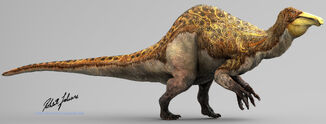
More up to date illustration; done by Robert Fabiani
Currie stated in an interview that it was a policy of their team to investigate quarries after they had been looted and recover anything of significance, and that finding any new Deinocheirus fossils was cause for celebration, even without the poached parts. A virtual model of Deinocheirus revealed at the SVP presentation brought applause from the crowd of attending paleontologists, and the American palaeontologist Stephen L. Brusatte stated he had never been as surprised by a SVP talk, though new fossils are routinely presented at the conference.
After the new specimens were announced, it was rumoured that a looted skull had found its way to a European museum through the black market. The poached elements were spotted in a private European collection by the French fossil trader François Escuillé, who notified Belgian paleontologist Pascal Godefroit about them in 2011. They suspected the remains belonged to Deinocheirus, and contacted the Korean-Mongolian team. Escuillé subsequently acquired the fossils and donated them to the Royal Belgian Institute of Natural Sciences. The recovered material consisted of a skull, a left hand, and feet, which had been collected in Mongolia, sold to a Japanese buyer, and resold to a German party (the fossils also passed through China and France).
The team concluded that these elements belonged to specimen MPC-D 100/127, as the single leftover toe bone fit perfectly into the unprepared matrix of a poached foot, the bone and matrix matched in colour, and because the elements belonged to an individual of the same size, with no overlap in skeletal elements. On May 1, 2014, the fossils were repatriated to Mongolia by a delegation from the Belgian Museum, during a ceremony held at the Mongolian Academy of Sciences. The reunited skeleton was deposited at the Central Museum of Mongolian Dinosaurs in Ulaanbaatar, along with a Tarbosaurus skeleton which had also been brought back after being stolen. American palaeontologist Thomas R. Holtz stated in an interview that the new Deinocheirus remains looked like the "product of a secret love affair between a hadrosaur and Gallimimus".
A pair of Deinocheirus. Credit: tyrannoninja
Cast of specimen MPC-D 100/127's skull (the first known skull of this genus), on exhibit at Munich Fossil Show Combined with the poached elements, both new specimens represent almost the entire skeleton of Deinocheirus, as MPC-D 100/127 includes all material apart from the middle dorsal vertebrae, most caudal vertebrae, and the right forelimb; MPC-D 100/128 fills in most gaps of the other skeleton, with nearly all dorsal and caudal vertebrae, the ilium, a partial ischium, and most of the left hindlimb. In 2014, the specimens were described by Lee, Barsbold, Currie, Yoshitsugu Kobayashi, Hang-Jae Lee Lee, Godefroit, Escuillié, and Tsogtbaatar Chinzorig. A similar series of events was reported earlier in 2014 with Spinosaurus, another sail-backed theropod which had only been known from few remains since 1912.
Poached remains were reunited with specimens obtained by scientists, and Spinosaurus was shown to have been quite different from other spinosaurids. The two cases showed that the lifestyle and appearance of incompletely known extinct animals cannot always be safely inferred from close relatives. By 2017, the Mongolian government had increased its effort to seize poached fossils from collectors and repatriate them, but proving their provenance had become a scientific and political concern. Therefore, a study tested the possibility of identifying poached fossils by geochemical methods, using Deinocheirus and other Nemegt dinosaurs as examples. In 2018, numerous large, tridactyl (three-toed) tracks were reported from the Nemegt locality (discovered in 2007 alongside sauropod tracks). Though the tracks were similar to those of hadrosaurs, no tracks of hadrosaur hands were identified, and since the feet of Deinocheirus are now known to have been similar to those of hadrosaurs, it cannot be ruled out that the tracks were made by this genus.
Description[]

Size of Deinocheirus compared to a human
The most well-preserved parts of Deinocheirus are its forelimbs, which measured 2.4 meters (8 feet) long — a 938 mm humerus, 688 mm ulna and 770 mm hand — including up to 19.6 centimeters (8 inches) long recurved claws. Each scapulocoracoid of the shoulder girdle has a length of 153 centimetres. The neck must also have been massive with each half of the paired ceratobranchialia measuring 42 centimetres.
The gigantic size of these skeletal elements has generated much speculation about the magnitude of the animal as a whole. Osmólska and Roniewicz thought it could be best compared with the Ornithomimosauria, as the structure of its arms is similar to the members of this group. Should Deinocheirus itself be a member this would make it by far the largest ornithomimosaur, indeed, one of the largest theropods. The describers estimated its size to be equal to the largest specimens of Tyrannosaurus.Its weight was in 1988 estimated by Gregory S. Paul to have been between six and twelve tonnes.Later estimates confirmed a number of roughly 9,000 kilograms (20,000 lbs). In 2010 Paul revised this to a length of ten meters and a weight of two tonnes.
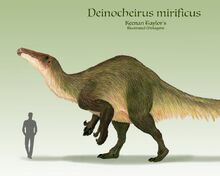
Paleo recreation; done by artist: IllustratedMenagerie
In 2010, Phil Senter and H.J. Robins attempted to estimate the total height at the hip of Deinocheirus. By studying more completely known theropods, they found that the length of the scapula (shoulder blade), better than that of the humerus (upper arm bone), could be used to accurately predict hip height. Using the equation found over a range of theropods, Senter and Robins determined that Deinocheirus likely measured 3.3 meters (11 feet) -3.6 meters (12 feet) tall at the hip. This places it as possibly the tallest known theropod, taller than any contemporary predators such as Tarbosaurus.
Though the arms of Deinocheirus have a considerable absolute size, being the longest of any known theropod, they are not very long relative to the shoulder girdle, the ratio being less than that with most ornithomimosaurs. The shoulder-blade is long and narrow. The humerus is relatively slender. radius The ulna and too are elongated and not very firmly connected to each other in a syndesmosis. metacarpus The is long compared to the fingers. The hand had a good mobility relative to the lower arm but was only capable of a limited flexing motion, unable to close in grasping. The fingers are about equal in length to each other, the first being the stoutest and the second the longest. Only the claw of the left second finger has been preserved in its entirety; it has a diameter of 196 millimetres and a length along its outer curvature of 323 millimetres.
Deinocheirus's diet is uncertain, but due to its classification and the fact that fish scales and plants were discovered inside the stomach, it is most likely an omnivore. Although, it is accepted that Deinocheirus wouldn't have attempted to actively bring down prey. Instead, Deinocheirus may have eaten insects, small dinosaurs as well as other small animals, and fish in carnivorous terms. Furthermore, the mouth was adapted to eat small plants and animals, and occasionally, fungi.
Classification[]
When Deinocheirus was only known from the original forelimbs, its taxonomic relationship was difficult to determine, and several hypotheses were proposed. Osmólska and Roniewicz initially concluded that Deinocheirus did not belong in any already named theropod family, so they created a new, monotypic family Deinocheiridae, placed in the infraorder Carnosauria.
This was due to the large size and thick-walled limb bones, but they also found some similarities with Ornithomimus, and, to a lesser extent, Allosaurus. In 1971, John Ostrom first proposed that Deinocheirus belonged with the Ornithomimosauria, while noting that it contained both ornithomimosaurian and non-ornithomimosaurian characters. In 1976, Rhinchen Barsbold named the order Deinocheirosauria, which was to include the supposedly related genera Deinocheirus and Therizinosaurus.
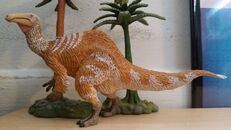
Deinocheirus reconstruction. Credit: wild safari©
A relationship between Deinocheirus and the long-armed therizinosaurs was supported by some later writers, but they are not considered to be closely related today, despite its somewhat Therizinosaurid appearance. In spite of this scientific conclusion, many different paleo-media depict Deinocheirus as an Therizinosaurid animal, or at least with Therizinosaurid traits which frequently mislead the entirety of the subject.
In 2004, Peter Makovicky, Kobayashi and Currie pointed out that Deinocheirus was likely a primitive ornithomimosaurian, since it lacked some of the features typical of the Ornithomimidae family. Primitive traits include its recurved claws, the low humerus-to-scapula ratio, and the lack of a syndesmosis. A 2006 study by Kobayashi and Barsbold found Deinocheirus to be possibly the most primitive ornithomimosaur, but was unable to further resolve its affinities, due to the lack of skull and hindlimb elements. A cladistic analysis accompanying the 2014 description of the two much more complete specimens found that Deinocheirus formed a clade with Garudimimus and Beishanlong, which were therefore included in the Deinocheiridae.
Paleobiology[]
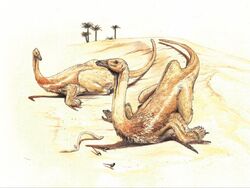
An artist's rendition of a pair of nesting Deinocherius; illustration done by joschua knuppe
The blunt and short hand-claws of Deinocheirus were similar to those of the therizinosaur Alxasaurus, which indicates the long arms and claws were used for digging and gathering plants. The blunt claws of the feet could have helped the animal from sinking into substrate when wading. The robust hind limbs and hip region indicates the animal moved slowly. The large size of the animal may have helped it against predators such as Tarbosaurus, but in turn it lost the running ability of other ornithomimosaurs. The long neural spines and possible tail fan may have been used for display behaviour. Deinocheirus was likely diurnal (active during the day), since the sclerotic rings of the eyes were relatively small in comparison with its skull length. The hand had good mobility relative to the lower arm, but was capable of only a limited flexing motion, unable to close in grasping.
The brain of Deinocheirus was reconstructed through CT scans and presented at the 2014 Society of Vertebrate Palaeontology conference. The brain was globular and similar in shape to that of birds and troodontid theropods, the cerebrum was expanded in a way similar to most theropods, and the olfactory tracts were relatively large. The brain was proportionally small and compact, and its reptile encephalization quotient (brain-body ratio) was estimated at 0.69, which is low for theropods, and similar to sauropods. Other ornithomimosaurs have proportionally large brains, and the small brain of Deinocheirus may reflect its social behaviour or diet. Its coordination and balance would not have been as important as for carnivorous theropods. In 2015, Akinobu Watanabe and colleagues found that together with Archaeornithomimus and Gallimimus, Deinocheirus had the most pneumatised skeleton among ornithomimosaurs. Pneumatisation is thought to be advantageous for flight in modern birds, but its function in non-avian dinosaurs is not known with certainty. It has been proposed that pneumatisation was used to reduce the mass of large bones (associated with gigantic size in the case of Deinocheirus), that it was related to high metabolism, balance during locomotion, or used for thermoregulation.
A bone microstructure study presented at the European Association of Vertebrate Palaeontologists in 2015 showed that Deinocheirus probably had a high metabolic rate, and grew rapidly before reaching sexual maturity. A histological study of a gastralia fragment from the holotype presented at a 2018 conference showed that its internal structure was similar to that of ossified tendons of other theropods. The osteons contained possible canaliculi, which would be the first-known occurrence of such structures in a basal ornithomimosaur. The structure of the periosteum and lack of growth arrest lines suggests that the holotype was a fully grown adult.
Potential inter-species conflict and Predation[]
Bite marks attributable to Tarbosaurus bataar are identified on fragments of gastralia from the giant putative ornithomimosaur, Deinocheirus mirificus. Hundreds of bone fragments collected from the holotype quarry of D. mirificus by members of the Korea-Mongolia International Dinosaur Project at Altan Uul III (Mongolia) were visually inspected for biomodification.
Parallel striae and gouges were identified on two gastralia, which are interpreted as bite marks. Serration marks, interpreted from parallel striae, are broadly U-shaped and measure 0.5 mm in diameter. A comparison of these marks with the denticles of Nemegt theropods reveals the tyrannosaur, Tarbosaurus as the most likely culprit. The identification of tyrannosaur bite marks on the bones of D. mirificus sheds light on both the diet of Tarbosaurus and the taphonomy of the only known specimen of Deinocheirus.[1]
Diet[]
The distinct shape of the skull shows that Deinocheirus had a more derived diet than other ornithomimosaurs. The beak was similar to that of ducks, which indicates it may have likewise foraged in water, or browsed near the ground like some sauropods and hadrosaurs. The attachment sites for the muscles that open and close the jaws were very small in comparison to the size of the skull, which indicates Deinocheirus had a weak bite force. The skull was likely adapted for cropping soft understory or water vegetation. The depth of the lower jaw indicates the presence of a large tongue, which could have assisted the animal in sucking in food material obtained with the broad beak when foraging on the bottom of freshwater bodies.
Cast of a hand-claw, showing its blunt, recurved shape. More than 1,400 gastroliths (stomach stones, 8 to 87 mm in size) were found among the ribs and gastralia of specimen MPC-D100/127. The ratio of gastrolith mass to total weight, 0.0022, supports the theory that these gastroliths helped the toothless animals in grinding their food. Features such as the presence of a beak and a U-shaped, downturned jaw, are indicators of facultative (optional) herbivory among coelurosaurian theropods. In spite of these features, fish vertebrae and scales were also found among the gastroliths, which suggests that it was an omnivore. Ornithomimosaurs in general are thought to have fed on both plants and small animals.
David J. Button and Zanno found in 2019 herbivorous dinosaurs mainly followed two distinct modes of feeding, either processing food in the gut—characterized by gracile skulls and low bite forces—or the mouth, characterized by features associated with extensive processing. Deinocheirus, along with ornithomimid ornithomimosaurs, diplodocoid and titanosaur sauropods, Segnosaurus, and caenagnathids, was found to be in the former category.
These researchers suggested that deinocheirids and ornithomimid ornithomimosaurians such as Gallimimus had invaded these niches separately, convergently achieving relatively large sizes. Advantages from large body mass in herbivores include increased intake rate of food and fasting resistance, and these trends may therefore indicate that deinocheirids and ornithomimids were more herbivorous than other ornithomimosaurians. They cautioned that the correlations between body mass and body mass were not simple, and that there was no directional trend towards increased mass seen in the clade. Furthermore, the diet of most ornithomimosaurians is poorly known, and Deinocheirus appears to have been at least opportunistically omnivorous.
Various feeding behaviors were proposed before more complete remains of Deinocheirus were known, and it was early on envisioned as a predatory, allosaur-like animal with giant arms. In their original description, Osmólska and Roniewicz found that the hands of Deinocheirus were unsuited for grasping, but could instead have been used to tear prey apart. In 1970, the Russian paleontologist Anatoly Konstantinovich Rozhdestvensky compared the forelimbs of Deinocheirus to sloths, leading him to hypotheses that Deinocheirus was a specialized climbing dinosaur, that fed on plants and animals found in trees. In 1988, Gregory S. Paul instead suggested that the claws were too blunt for predatory purposes, but would have been good defensive weapons.
While attempting to determine the ecological niches for Deinocheirus and Therizinosaurus in 2010, Phil Senter and James H. Robins suggested that Deinocheirus had the largest vertical feeding range due to its hip height, and specialized in eating high foliage. In 2017, it was suggested that the claws of Deinocheirus were adapted for pulling large quantities of herbaceous plants out of water, and to decrease the resistance of water.
Paleoenvironment[]
The three known Deinocheirus specimens were recovered from the Nemegt Formation in the Gobi Desert of southern Mongolia. This geologic formation has never been dated radiometrically, but the fauna present in the fossil record indicate it was probably deposited during the early Maastrichtian age, at the end of the Late Cretaceous about 70 million years ago. The rock facies of the Nemegt Formation suggest the presence of stream and river channels, mudflats, and shallow lakes. Such large river channels and soil deposits are evidence of a far more humid climate than those found in the older Barun Goyot and Djadochta formations. However, caliche deposits indicate at least periodic droughts occurred. Sediment was deposited in the channels and floodplains of large rivers.
Deinocheirus is thought to have been widely distributed within the Nemegt Formation, as the only three specimens found have been 50 km (31 mi) apart. The river systems of the Nemegt Formation provided a suitable niche for Deinocheirus with its omnivorous habits. The environment was similar to the Okavango Delta of present-day Botswana. Within this ecosystem, Deinocheirus would have eaten plants and small animals, including fish. It may have competed for trees with other large herbivorous dinosaurs such as the long-necked theropod Therizinosaurus, various titanosaurian sauropods, and the smaller hadrosaurid Saurolophus. Deinocheirus may have competed with those herbivores for higher foliage such as trees, but was also able to feed on material that they could not. Along with Deinocheirus, the discoveries of Therizinosaurus and Gigantoraptor show that three groups of herbivorous theropods (ornithomimosaurs, therizinosaurs and oviraptorosaurs), independently reached their maximum sizes in the late Cretaceous of Asia.
The habitats in and around the Nemegt rivers where Deinocheirus lived provided a home for a wide array of organisms. Occasional mollucs fossils are found, as well as a variety of other aquatic animals like fish and turtles, and the crocodylomorph Shamosuchus. Mammal fossils are rare in the Nemegt Formation, but many birds have been found, including the enantiornithine Gurilynia, the hesperornithiform Judinornis, as well as Teviornis, a possible Anseriform. Herbivorous dinosaurs of the Nemegt Formation include ankylosaurids such as Tarchia, the pachycephalosaurian Prenocephale, large hadrosaurids such as Saurolophus and Barsboldia, and sauropods such as Nemegtosaurus, and Opisthocoelicaudia. Predatory theropods that lived alongside Deinocheirus include tyrannosauroids such as Tarbosaurus, Alioramus, and Bagaraatan, and troodontids such as Borogovia, Tochisaurus, and Zanabazar. Theropod groups with both omnivorous and herbivorous members include therizinosaurs, such as Therizinosaurus, oviraptorosaurians, such as Elmisaurus, Nemegtomaia, and Rinchenia, and other ornithomimosaurians, such as Anserimimus and Gallimimus.
Other Wikis[]
In popular culture[]
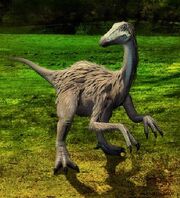
Deinocheirus in Jurassic World: The Game
- Deinocheirus appeared in Bizarre Dinosaurs, and is depicted with a therizinosaur body shape, due to the body not being discovered yet. This model is outdated.
- Deinocheirus appeared in Jurassic World: The Game as a tournament dinosaur. While it is accurately portrayed with a coat of feathers, it is shown inaccurately due its lack of fatty tissue and pronated wrists. Its hump appears to be much less pronounced than in real life, until its final evolution. Despite being an ornithomimid, in the game, it uses the same model for the therizinosaurids, Therizinosaurus, Segnosaurus, and Erlikosaurus although it is likely because Deinocheirus looks more like a therizinosaurid than a ornithomimid.
- Deinocheirus appeared in the mobile game, Jurassic World: Alive as a Common dinosaur. Similar to it's depiction in Jurassic World: The Game, Jurassic World: Alive's model of Deinocheirus is greatly inaccurate. For starters, it is able to pronate its wrists, which has been widely accepted that Theropods could not pronate their wrists as we can. Its hump is minor in definition as well, and the model uses the same animation rig for Therizinosaurids, which is a misleading aspect, as Deinocheirus, despite its resemblances, is indeed not a Therizinosaurid.
- A young Deinocherius named Dennis appeared in a 2 part episode of Dinosaur Train.
- A female Deinocheirus is one of the main characters in the 2019 NHK documentary, Amazing Dinoworld. It is shown accurately with feathers.
- A male Deinochierus appeared in episode 3 of Prehistoric Planet, "Freshwater", where it was featured with long almost fur-like feather coating, grazing in a shallow swamp and scratching an itch from bloodsucking flies on a dead tree.
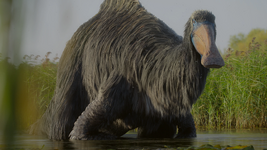
Prehistoric Planet's reconstruction of Deinochieirus
- Deinocheirus will be added to the Roblox game Prior Extinction in the Rise & Fall update.
- Deinocheirus was added to Jurassic World Evolution 2 via the Feathered Species Pack on March 30th, 2023. This species is among the most scientifically accurate in the game, along with the other species in the pack.
- Deinocheirus also appears in the game Prehistoric Kingdom.
- Deinocheirus is a playable in the the Dinosaur survival game, Path Of Titans.
References[]
- https://www.nature.com/articles/nature13874
- https://eartharchives.org/articles/deinocheirus-the-giant-hunchbacked-dinosaur-with-terrifying-hands/index.html
- http://palaeontologia.pan.pl/Archive/1968-19_7-30_1-4.pdf
- http://palaeontologia.pan.pl/Archive/1969-21_5-22_1-5.pdf
- http://cactus.dixie.edu/jharris/Kobayashi%26Barsbold_ornithomimids.pdf
- https://www.academia.edu/1900689
- https://web.archive.org/web/20150202164543/http://www.dinocasts.com/prod_catalog3_exhibit.asp?ObjectId=24
- https://ui.adsabs.harvard.edu/abs/2018PPP...494...51F
- https://www.nationalgeographic.com/culture/article/131104-dinosaur-hands-arms-body-mongolia
- https://www.newscientist.com/article/dn25551-stolen-dinosaur-head-reveals-weird-hybrid-species/?ignored=irrelevant
- https://www.sciencedirect.com/science/article/abs/pii/S0262407920303146?via%3Dihub
- https://web.archive.org/web/20140512213648/http://www.infomongolia.com/ct/ci/7787
- https://www.nature.com/articles/nature13930
- https://www.researchgate.net/publication/267745382_Resolving_the_long-standing_enigmas_of_a_giant_ornithomimosaur_Deinocheirus_mirificus
- https://www.researchgate.net/figure/Deinocheirus-Deinocheirus-mirificus-height-3-4-m-24_fig7_338327588
- https://www.researchgate.net/publication/278358391_Mystery_of_the_horrible_hands_solved
- https://www.researchgate.net/figure/A-dinosaur-emerges-Two-new-almost-complete-skeletons-of-Deinocheirus-mirificus_fig1_267758694
- https://www.researchgate.net/publication/267758694_Palaeontology_Mystery_of_the_horrible_hands_solved
- https://www.researchgate.net/publication/280132120_First_insights_into_the_bone_microstructure_of_Deinocheirus_mirificus
- https://www.ncbi.nlm.nih.gov/pmc/articles/PMC4684312/
- https://www.cell.com/current-biology/fulltext/S0960-9822(19)31390-9?_returnURL=https%3A%2F%2Flinkinghub.elsevier.com%2Fretrieve%2Fpii%2FS0960982219313909%3Fshowall%3Dtrue
- https://www.nationalgeographic.com/science/article/deinocheirus-exposed-meet-the-body-behind-the-terrible-hand
- https://dinomuseum.ca/2020/01/28/the-weird-dinosaurs-saga-deinocheirus/
- https://www.nhm.ac.uk/discover/dino-directory/deinocheirus.html
- https://www.thoughtco.com/deinocheirus-the-hand-dinosaur-1093782
- https://www.nature.com/articles/nature13874